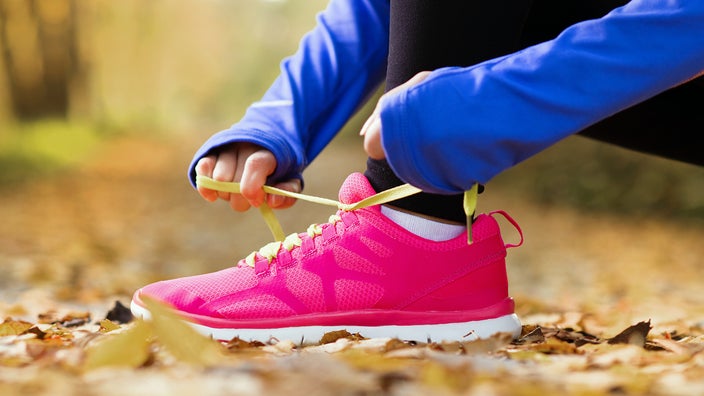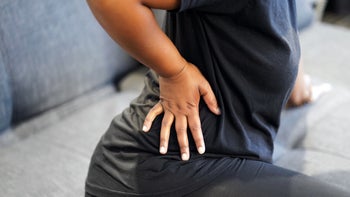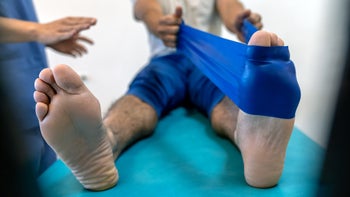
Should You Try Zero-Drop Shoes for Better Balance and Stride?
Key takeaways:
Zero-drop shoes are flat. Their minimal cushioning keeps the heel and forefoot on the same level.
Because they allow more natural movement, zero-drop shoes help strengthen your foot muscles. They may also improve balance, reduce pain, and enhance athletic performance.
It’s best to gradually transition to zero-drop shoes. Wear them while walking before progressing to running.

Zero-drop shoes might sound like a new sneaker brand, but they are designed to mimic barefoot movement. They're very different from the highly cushioned, supportive shoes many of us wear. And research suggests they have several benefits.
The shoes were developed around 2008. At that time, marathon runner and exercise science major Golden Harper believed uneven shoes contributed to injuries. So, he shaved the extra cushioning off his running shoes to make a completely flat shoe, which he later called zero drop. He went on to co-found the shoe company Altra with Brian Beckstead. The zero-drop shoe movement took off from there.
What are zero-drop shoes?
Shoe drop refers to the height difference between the heel and forefoot of a shoe. A stiletto, for example, has a high heel-to-toe drop, while the average running shoe has a low 10 mm drop. A zero-drop shoe has a completely flat sole, so the heel and forefront are all on the same level.
Search and compare options
Zero-drop and minimalist shoes are often used interchangeably, but they are different. While zero-drop shoes may have some cushioning, minimalist shoes do not. Many people wear zero-drop shoes while running, but you can wear them for other activities, such as hiking or weightlifting.
What are the benefits of zero-drop shoes?
The theory behind zero-drop shoes is that they allow more movement by mimicking being barefoot. This design should help keep your spine aligned and maintain your gait or walking pattern.
In fact, the American College of Sports Medicine (ACSM) recommends zero- or low-drop (6 mm or less) shoes for running. According to the ACSM, running shoes should have minimal arch support and cushioning so they don't overcompensate for what your foot should do naturally.
Let's dive into the specific benefits of zero-drop shoes.
Strengthen your foot muscles
Your feet act as the foundation of your body. Strong foot and ankle muscles help support and move your body, preventing injury. It might sound counterintuitive, but highly cushioned shoes may weaken those muscles. The added support can be comfortable while walking or running. But it also means lower-body muscles in your legs and feet do less work. Weaker muscles can make you more susceptible to injuries.
A 2019 study found that minimalist shoe walking increased foot muscle size and strength as much as foot-strengthening exercises. So the right shoes can help keep your feet strong while you walk or run.
Improve your balance
As your foot muscles strengthen through wearing zero-drop shoes, you may feel more stable and have better balance. A review found that foot muscle strength, specifically toe flexor strength, improved balance in people over 60. Another study found that minimalist shoes improved stability and mobility in people with a history of falls.
Encourage a better stride pattern
Zero-drop shoes may encourage a forefoot or midfoot striking pattern while walking or running, at least in the short term. Research suggests that forefoot strikers have better shock absorbency and fewer foot and knee injuries than heel-first strikers.
But zero-drop shoes may be less effective as your body adjusts and compensates. A 2017 study found that after 6 months, zero-drop shoes showed slightly less stress on the knees while running on the treadmill. But there were no other differences in strike pattern in the long term.
Reduce muscle pain
You would think that highly cushioned shoes would help with shock absorbency and pain, but a 2018 study found the opposite. Highly cushioned shoes alter running mechanics, increase the shock impact on your legs, and cause leg stiffness. This can lead to overuse injuries. As noted above, zero-drop shoes may help strengthen your foot muscles. And stronger muscles could mean less foot, knee, ankle, or back pain.
Enhance athletic performance
A European Journal of Sports Science study found that minimalist shoes may help you run faster. When runners wore them while training, their feet and calves got stronger. After 20 weeks, they did a 5K trial run on the treadmill. They were faster and more efficient than runners who did not wear minimalist shoes.
But these improvements were seen when runners wore them for up to 35% of their training. After that, there was no difference. So you don't necessarily only have to wear zero-drop shoes to get these benefits.
Are there risks of wearing zero-drop shoes?
Zero-drop shoes are generally safe for most people. But give yourself time to properly transition into them. The shoes can cause a midfoot strike instead of a heel strike. And research shows it may put more stress on your Achilles tendon. If you have tendonitis or feel pain while exercising, switch to a shoe with a higher drop.
Wearing zero-drop shoes might help prevent plantar fasciitis by strengthening your foot muscles. But if you already have the condition, zero-drop shoes may aggravate your symptoms. The same goes for those with flat feet. Zero-drop shoes will help strengthen your feet to improve their normal function. But some people with flat feet feel more comfortable in shoes with a supportive arch.
How do you transition to zero-drop shoes?
The American College of Sports Medicine recommends gradually transitioning to zero-drop shoes. This is especially important if you’ve been wearing highly cushioned shoes with arch supports. Zero-drop shoes activate different muscles, so you may initially feel soreness in your hip, gluteal (buttock), or calf muscles.
Here are some tips to make the transition smoother:
If you're used to a high-drop shoe, try a moderate heel drop (6 mm or 8 mm) before switching to zero drop.
Slowly work your way up to wearing zero-drop shoes regularly or during training, if that's your goal. Start by walking in the shoes for 30 to 60 minutes each day for a few weeks.
Once you can walk without discomfort, gradually shift to running. Increase your distance by about 10% each week in your new shoes.
Add calf, foot, and hip stretches to your routine to keep your muscles loose.
Be prepared for it to take a month or longer before you are fully acclimated and can walk or run your normal distance.
Always listen to your body, and take off zero-drop shoes if you feel significant, lingering, or worsening pain.
The bottom line
Unlike standard sneakers, zero-drop shoes are flat, with little to no cushioning. They may strengthen foot muscles and improve your balance and walking stride. But they might not be suitable for people with certain conditions, including Achilles tendonitis, plantar fasciitis, or flat feet. If you try zero-drop shoes, slowly transition into them, gradually increasing the time you wear them each day.
Why trust our experts?



References
American College of Sports Medicine. (2014). Selecting running shoes.
Cheung, R. T. H., et al. (2016). Relationship between foot strike pattern, running speed, and footwear condition in recreational distance runners. Sports Biomechanics.
Cudejko, T., et al. (2020). Minimal shoes improve stability and mobility in persons with a history of falls. Scientific Reports.
Fuller, J. T., et al. (2018). Longer-term effects of minimalist shoes on running performance, strength and bone density: A 20-week follow-up study. European Journal of Sport Science.
Golden Harper. (2021). Altra founder Golden Harper’s story of how and why Altra shoes were invented & came to be.
Kulmala, J-P., et al. (2013). Forefoot strikers exhibit lower running-induced knee loading than rearfoot strikers. Medicine and Science in Sports and Exercise.
Kulmala, J-P., et al. (2018). Running in highly cushioned shoes increases leg stiffness and amplifies impact loading. Scientific Reports.
Malisoux, L., et al. (2017). Adaptation of running pattern to drop of standard cushioned shoes: A randomized controlled trial with 6-month follow-up. Journal of Science and Medicine in Sport.
Quinlan, S., et al. (2020). The evidence for improving balance by strengthening the toe flexor muscles: A systematic review. Gait & Posture.
Ridge, S. T., et al. (2019). Walking in minimalist shoes is effective for strengthening foot muscles. Medicine and Science in Sports and Exercise.
Stull, K. (2022). Exercises for the midfoot and heel: Smart corrective steps. American Fitness Magazine.
Subic, J. (2021). Heel to toe drop: The ultimate guide. RunRepeat.

























